High Sensitivity Humidity Detection Based on Functional GO/MWCNTs Hybrid Nano-Materials Coated Titled Fiber Bragg Grating
Abstract
:1. Introduction
2. Principle and Experimental System
3. Experimental Results and Discussion
4. Conclusions
Author Contributions
Funding
Data Availability Statement
Conflicts of Interest
References
- Zhang, L.; Gu, F.; Lou, J.; Yin, X.; Tong, L. Fast detection of humidity with a subwavelength-diameter fiber taper coated with gelatin film. Opt. Express 2008, 16, 13349–13353. [Google Scholar] [CrossRef] [PubMed]
- Yeo, T.L.; Sun, T.; Grattan, K.T.V. Fibre-optic sensor technologies for humidity and moisture measurement. Sens. Actuators Phys. 2008, 144, 280–295. [Google Scholar] [CrossRef]
- Enjin, A.; Zaharieva, E.E.; Frank, D.D.; Mansourian, S.; Suh, G.S.; Gallio, M.; Stensmyr, M.C. Humidity sensing in drosophila. Curr. Biol. 2016, 26, 1352–1358. [Google Scholar] [CrossRef] [PubMed]
- Fanget, S.; Hentz, S.; Puget, P.; Arcamone, J.; Matheron, M.; Colinet, E.; Andreucci, P.; Duraffourg, L.; Myers, E.; Roukes, M.L. Gas sensors based on gravimetric detection—A review. Sens. Actuators Biol. Chem. 2011, 160, 804–821. [Google Scholar] [CrossRef]
- Duraia, E.S.M.; Beall, G.W. Humidity sensing properties of reduced humic acid. Sens. Actuators Biol. Chem. 2015, 220, 22–26. [Google Scholar] [CrossRef]
- Wang, Q.; Pan, Y.Z.; Huang, S.S.; Ren, S.T.; Li, P.; Li, J.J. Resistive and capacitive response of nitrogen-doped TiO2 nanotubes film humidity sensor. Nanotechnology 2010, 22, 025501. [Google Scholar] [CrossRef]
- Rivadeneyra, A.; Fernandez-Salmeron, J.; Agudo-Acemel, M.; Lopez-Villanueva, J.A.; Capitan-Vallvey, L.F.; Palma, A.J. Printed electrodes structures as capacitive humidity sensors: A comparison. Sens. Actuators A Phys. 2016, 244, 56–65. [Google Scholar] [CrossRef]
- Kolpakov, S.; Gordon, N.; Mou, C.; Zhou, K. Toward a new generation of photonic humidity sensors. Sensors 2014, 14, 3986–4013. [Google Scholar] [CrossRef]
- Sikarwar, S.; Yadav, B.C. Opto-electronic humidity sensor: A review. Sens. Actuators A Phys. 2015, 233, 54–70. [Google Scholar] [CrossRef]
- Chen, G.Y.; Lancaster, D.G.; Monro, T.M. Optical microfiber technology for current, temperature, acceleration, acoustic, humidity and ultraviolet light sensing. Sensors 2017, 18, 72. [Google Scholar] [CrossRef] [Green Version]
- Alberto, N.; Tavares, C.; Domingues, M.F.; Correia, S.F.H.; Marques, C.; Antunes, P.; Pinto, J.L.; Ferreira, R.A.S.; André, P.S. Relative humidity sensing using micro-cavities produced by the catastrophic fuse effect. Opt. Quantum Electron. 2016, 48, 216. [Google Scholar] [CrossRef]
- Fan, X.; Wang, Q.; Zhou, M.; Liu, F.; Shen, H.; Wei, Z.; Wang, F.; Tan, C.; Meng, H. Humidity sensor based on a graphene oxide-coated few-mode fiber Mach-Zehnder interferometer. Opt. Express 2020, 28, 24682–24692. [Google Scholar] [CrossRef] [PubMed]
- Chen, L.H.; Li, T.; Chan, C.C.; Menon, R.; Balamurali, P.; Shaillender, M.; Neu, B.; Ang, X.M.; Zu, P.; Wong, W.C.; et al. Chitosan based fiber-optic Fabry–Perot humidity sensor. Sens. Actuators B Chem. 2012, 169, 167–172. [Google Scholar] [CrossRef]
- Deng, S.; Meng, H.; Wang, X.; Fan, X.; Wang, Q.; Zhou, M.; Guo, X.; Wei, Z.; Wang, F.; Tan, C.; et al. Graphene oxide-film-coated splitting ratio adjustable Mach-Zehnder interferometer for relative humidity sensing. Opt. Express 2019, 27, 9232–9240. [Google Scholar] [CrossRef] [PubMed]
- Gu, B.; Yin, M.; Zhang, A.P.; Qian, J.; He, S. Optical fiber relative humidity sensor based on FBG incorporated thin-core fiber modal interferometer. Opt. Express 2011, 19, 4140–4146. [Google Scholar] [CrossRef]
- Berruti, G.; Consales, M.; Giordano, M.; Sansone, L.; Petagna, P.; Buontempo, S.; Breglio, G.; Cusano, A. Radiation hard humidity sensors for high energy physics applications using polyimide-coated fiber Bragg gratings sensors. Sens. Actuators B Chem. 2013, 177, 94–102. [Google Scholar] [CrossRef]
- Albert, J.; Shao, L.Y.; Caucheteur, C. Tilted fiber Bragg grating sensors. Laser Photonics Rev. 2013, 7, 83–108. [Google Scholar] [CrossRef]
- Alam, M.Z. In Situ Characterization of Single-Wall Carbon Nanotube Thin Film Growth Using the Polarization Properties of Tilted Fibre Bragg Gratings. Ph.D. Thesis, Carleton University, Ottawa, ON, Canada, 2012. [Google Scholar]
- Zhang, Y.; Wang, F.; Qian, S.Y.; Liu, Z.X.; Wang, Q.; Gu, Y.Y.; Wu, Z.L.; Jing, Z.G.; Sun, C.S.; Peng, W. A Novel Fiber Optic Surface Plasmon Resonance Biosensors with Special Boronic Acid Derivative to Detect Glycoprotein. Sensors 2017, 17, 2259. [Google Scholar] [CrossRef] [Green Version]
- Zhang, Y.; Wang, F.; Liu, Z.G.; Duan, Z.H.; Cui, W.L.; Han, J.; Gu, Y.; Wu, Z.L.; Jing, Z.G.; Sun, C.S.; et al. Fiber-optic anemometer based on single-walled carbon nanotube coated tilted fiber Bragg grating. Opt. Express 2017, 25, 24521–24530. [Google Scholar] [CrossRef]
- Bjorkqvist, M.; Salonen, J.; Paski, J.; Laine, E. Characterization of thermally carbonized porous silicon humidity sensor. Sens. Actuators A Phys. 2000, 112, 244–247. [Google Scholar] [CrossRef]
- Wu, S.; Wang, G.; Xue, Z.; Ge, F.; Zhang, G.; Lu, H.; Qiu, L. Organic field-effec transistors with macroporous semiconductor films as high-performance humidity sensors. ACS Appl. Mater. Interf. 2017, 9, 14974–14982. [Google Scholar] [CrossRef] [PubMed]
- Fratoddi, I.; Bearzotti, A.; Venditti, I.; Cametti, C.; Russo, M.V. Chemical role of nanostructured polymers on the improvement of electrical response-based relative humidity sensors. Sens. Actuators B Chem. 2016, 225, 96–108. [Google Scholar] [CrossRef] [Green Version]
- Nakajima, T.; Nakamura, T.; Tsuchiya, T. Flexible humidity sensors composed of graphite-like carbon micro-pinecone arrays. RSC Adv. 2016, 6, 95342–95348. [Google Scholar] [CrossRef] [Green Version]
- Zhang, D.; Wang, K.; Tong, J.; Xia, B. Layer-by-layer nanoassembly fabrication and humidity sensing behaviors of multi-walled carbon nanotubes/polyelectrolyte hybrid film. J. Nanosci. Nanotechnol. 2016, 7, 6705–6710. [Google Scholar] [CrossRef]
- Wong, W.C.; Chan, C.C.; Chen, L.H.; Li, T.; Lee, K.X.; Leong, K.C. Polyvinyl alcohol coated photonic crystal optical fiber sensor for humidity measurement. Sens. Actuators Biol. Chem. 2012, 174, 563–569. [Google Scholar] [CrossRef]
- Liu, H.F.; Miao, Y.P.; Liu, B.; Lin, W.; Zhang, H.; Song, B.B.; Huang, M.D.; Lin, L. Relative Humidity Sensor Based on S-Taper Fiber Coated with SiO2 Nanoparticles. IEEE Sens. J. 2015, 15, 3424–3428. [Google Scholar] [CrossRef]
- Luo, Y.; Chen, C.; Xia, K.; Peng, S.; Guan, H.; Tang, J.; Lu, H.; Yu, J.; Zhang, J.; Xiao, Y.; et al. Tungsten disulfide WS2-based all-fiber-optic humidity sensor. Opt. Express 2016, 24, 8956–8966. [Google Scholar] [CrossRef]
- Li, Z.Q.; Henriksen, E.A.; Jiang, Z.; Hao, Z.; Martin, M.C.; Kim, P.; Stormer, H.L.; Basov, D.N. Dirac charge dynamics in graphene by infrared spectroscopy. Nat. Phys. 2008, 4, 532–536. [Google Scholar] [CrossRef] [Green Version]
- Nair, R.R.; Wu, H.A.; Jayaram, P.N.; Grigorieva, I.V.; Geim, A.K. Unimpeded permeation of water through helium-leak-tight graphene-based membranes. Science 2012, 335, 442–444. [Google Scholar] [CrossRef] [Green Version]
- Wang, Y.Q.; Shen, C.Y.; Lou, W.M.; Shentu, F.Y.; Zhong, C.; Dong, X.Y.; Tong, L.M. Fiber optic relative humidity sensor based on the tilted fiber Bragg grating coated with graphene oxide. Appl. Phys. Lett. 2016, 109, 031107. [Google Scholar] [CrossRef]
- Prabuddha, K.S.; Dissanayake, W.; Wu, W.P.; Nguyen, H.; Sun, T.; Grattan, K.T.V. Graphene oxide–coated long period grating-based fiber optic sensor for relative humidity and external refractive index. J. Lightwave Technol. 2018, 36, 1145–1151. [Google Scholar]
- Zhao, Y.; Li, A.W.; Ming, X.Y.; Zhu, Y.Q.; Sun, X.C.; Li, P.; Yu, Y.S. Relative humidity sensor of S fiber taper based on graphene oxide film. Opt. Commun. 2019, 450, 147–154. [Google Scholar] [CrossRef]
- Zhang, C.; Ren, L.; Wang, X.; Liu, T. Graphene oxide-assisted dispersion of pristine multiwalled carbon nanotubes in aqueous media. J. Phys. Chem. C 2010, 35, 11435–11440. [Google Scholar] [CrossRef]
- Qiu, L.; Yang, X.; Gou, X.; Yang, W.; Ma, Z. Dispersing carbon nanotubes with graphene oxide in water and synergistic effects between graphene derivatives. Chem. Eur. J. 2010, 16, 10653–10658. [Google Scholar] [CrossRef] [PubMed]
- Li, X.Y.; Chen, X.D.; Chen, X.P.; Ding, X.; Zhao, X. High-sensitive humidity sensor based on graphene oxide with evenly dispersed multiwalled carbon nanotubes. Mater. Chem. Phys. 2018, 207, 135–140. [Google Scholar] [CrossRef]
- Wen, H.Y.; Huang, W.Y.; Huang, T.S.; Hsu, Y.C.; Chiang, C.C. Comparison of the sensing mechanisms and capabilities of three functional materials surface-modifed TFBG sensors. AIP Adv. 2020, 10, 065319. [Google Scholar] [CrossRef]

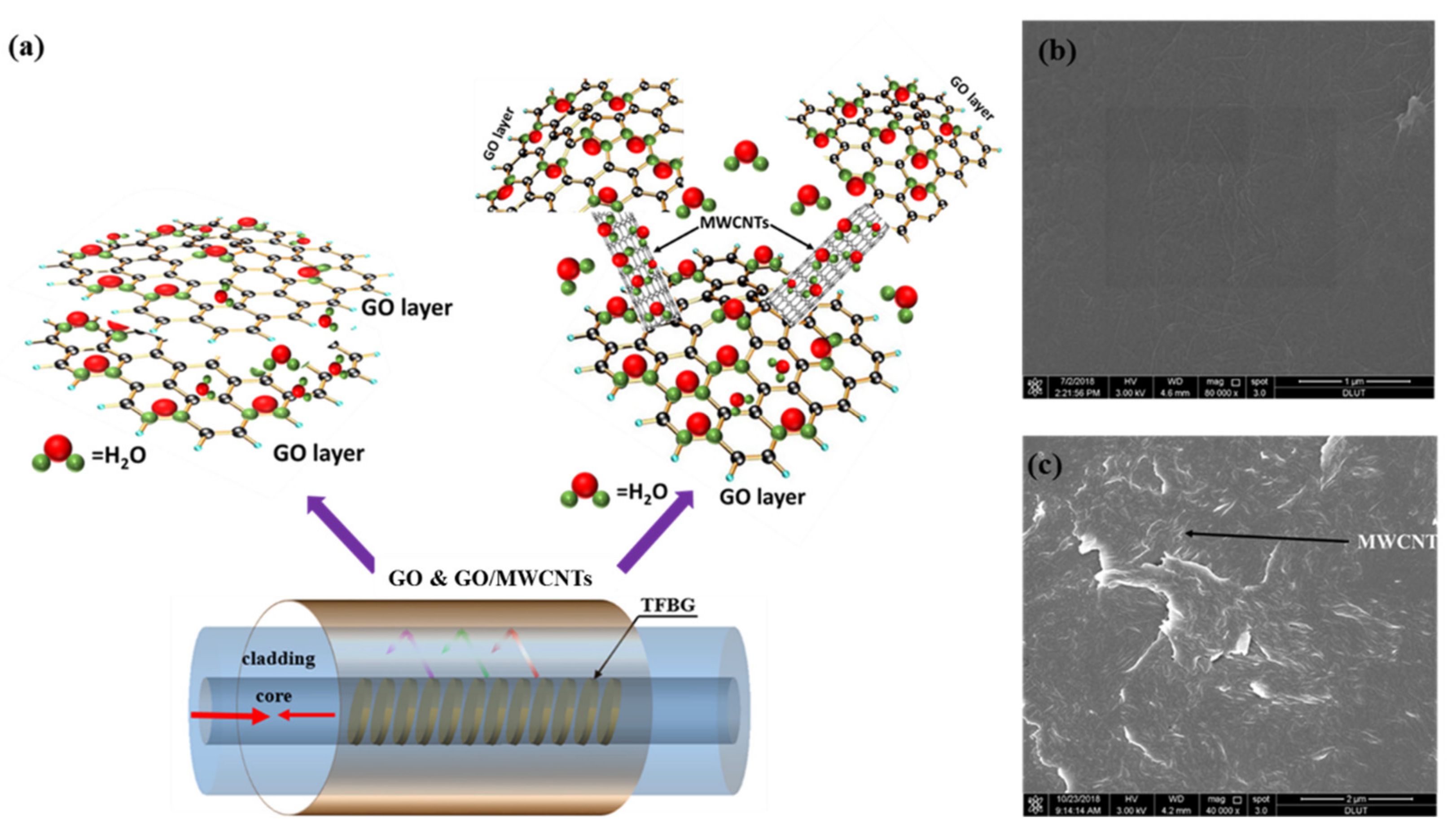
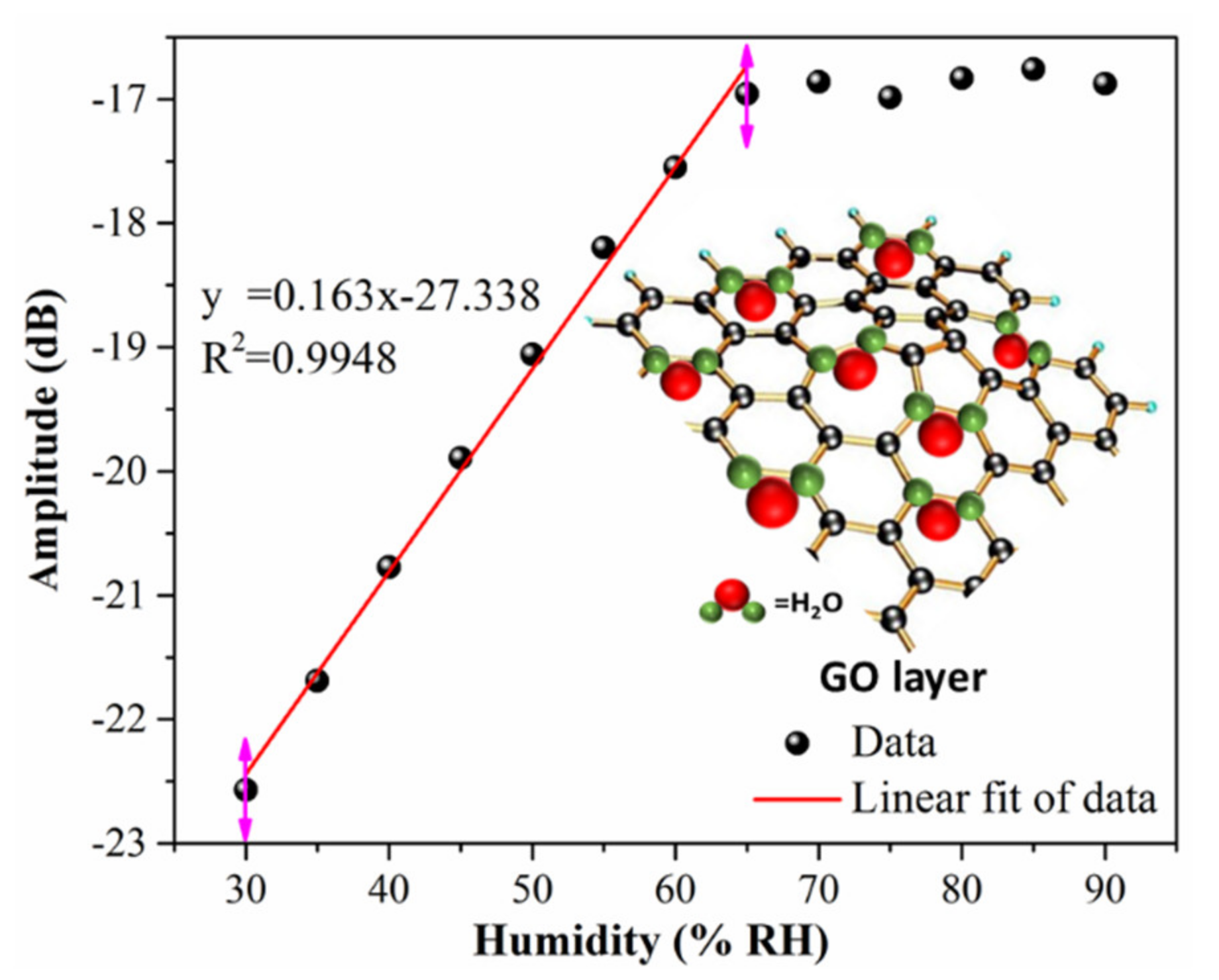
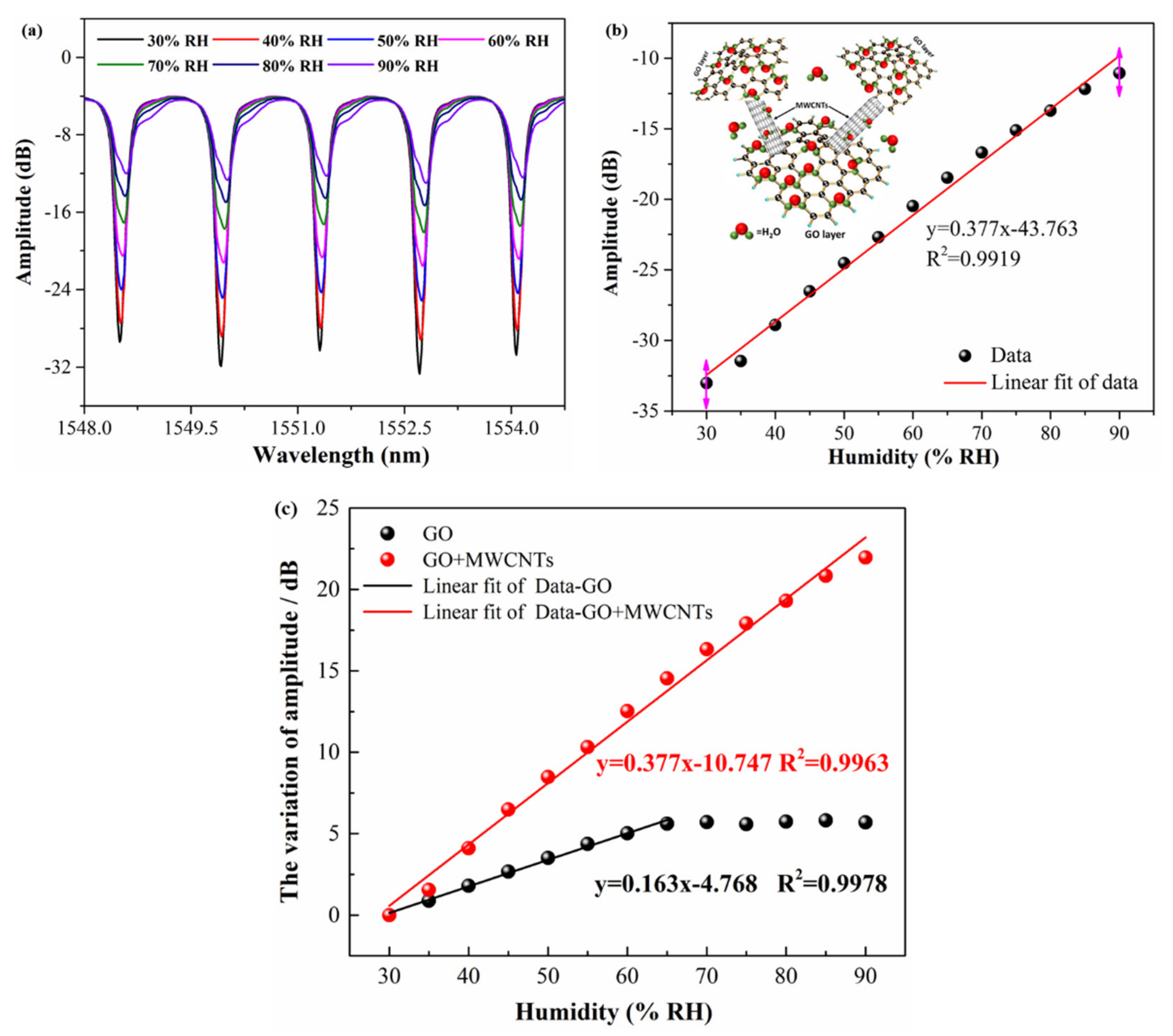
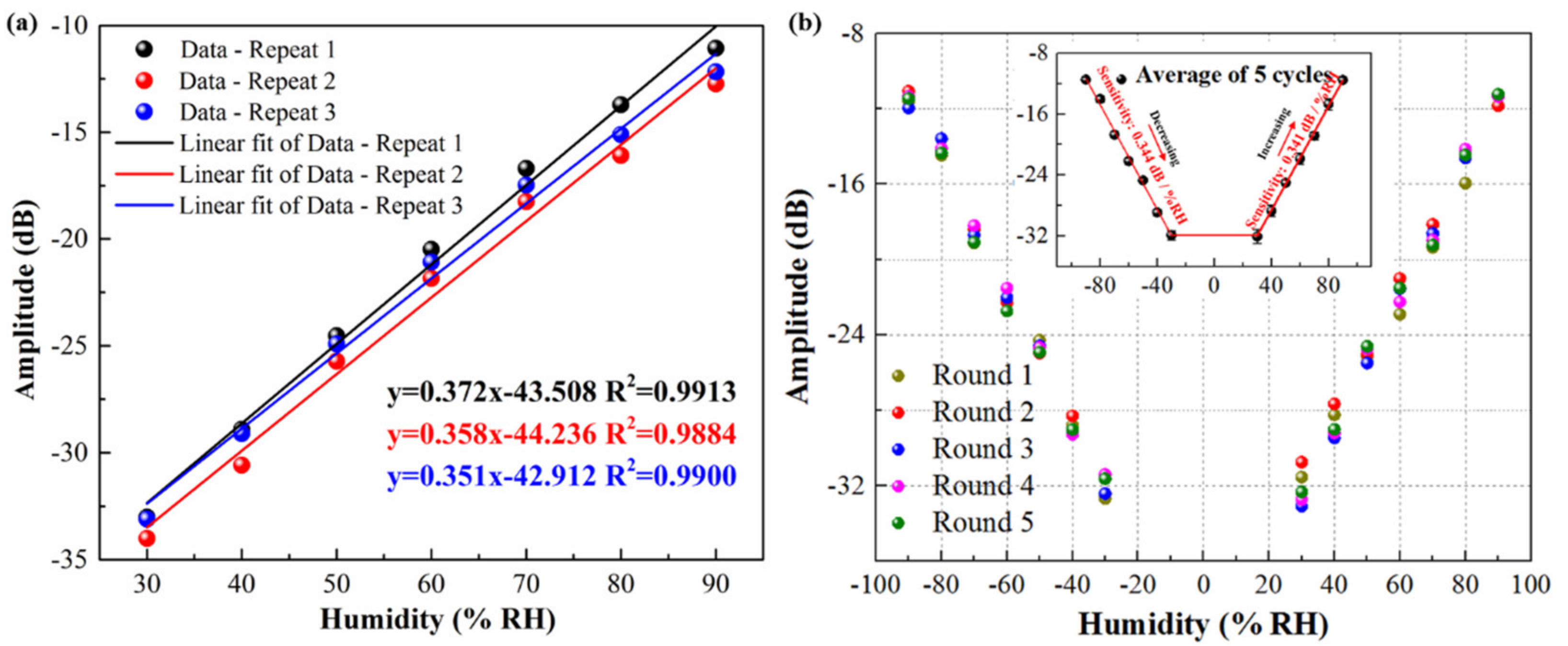
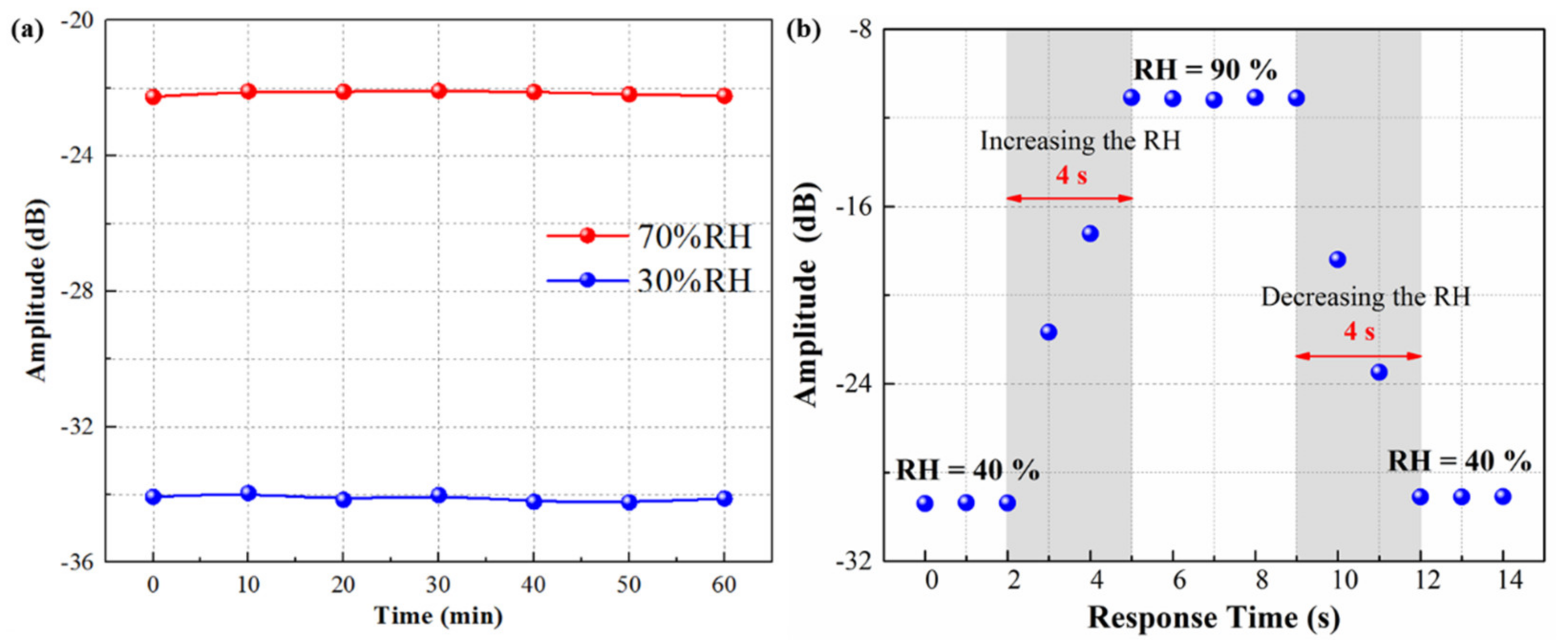
| Sensor Type | Material | Sensitivity | Range | Ref |
|---|---|---|---|---|
| TFBG | PEDOT:PSS | 0.015 dB/% RH | 20–80% RH | [37] |
| TFBG | PAHP4 | 0.00272 dB/% RH | 20–80% RH | [37] |
| TFBG | GO | 0.129 dB/% RH | 10–80% RH | [31] |
| S fiber taper | GO | 0.361 dB/% RH | 43–95% RH | [33] |
| MZI | GO | 0.263 dB/% RH | 35–85% RH | [14] |
| LPFG | GO | 0.15 dB/% RH | 60–95% RH | [32] |
| TFBG | GO/MWCNT | 0.377 dB/% RH | 30–90% RH | This work |
Publisher’s Note: MDPI stays neutral with regard to jurisdictional claims in published maps and institutional affiliations. |
© 2021 by the authors. Licensee MDPI, Basel, Switzerland. This article is an open access article distributed under the terms and conditions of the Creative Commons Attribution (CC BY) license (https://creativecommons.org/licenses/by/4.0/).
Share and Cite
Wang, F.; Wang, B.; Zhang, X.; Lu, M.; Zhang, Y.; Sun, C.; Peng, W. High Sensitivity Humidity Detection Based on Functional GO/MWCNTs Hybrid Nano-Materials Coated Titled Fiber Bragg Grating. Nanomaterials 2021, 11, 1134. https://doi.org/10.3390/nano11051134
Wang F, Wang B, Zhang X, Lu M, Zhang Y, Sun C, Peng W. High Sensitivity Humidity Detection Based on Functional GO/MWCNTs Hybrid Nano-Materials Coated Titled Fiber Bragg Grating. Nanomaterials. 2021; 11(5):1134. https://doi.org/10.3390/nano11051134
Chicago/Turabian StyleWang, Fang, Bowen Wang, Xuhui Zhang, Mengdi Lu, Yang Zhang, Changsen Sun, and Wei Peng. 2021. "High Sensitivity Humidity Detection Based on Functional GO/MWCNTs Hybrid Nano-Materials Coated Titled Fiber Bragg Grating" Nanomaterials 11, no. 5: 1134. https://doi.org/10.3390/nano11051134






